Omnivorous Fish:
The "Side B" of Golden Dorado Fishing
The upper stretch of the Parana River, where our Itati Lodge is located, is famous for its trophy golden dorado, which can exceed 40 pounds. The chance to battle these monster fish is what draws most anglers to the Parana River, but there is also a “Side B” for this adventure: fishing for multiple omnivorous species.
Even if golden dorado didn’t inhabit the Parana River, it would still be worth making the trip just to fish for the omnivorous species that also call this diverse river home. These species include pacu (piaractus mesopotamicus), pirapitas (two species: Brycon orbignyanusand Brycon hilarii) and boga (Megaleporinus obtusidens).These omnivorous species adapt their diet throughout the season and focus on what is most available to them, but they will also still feed opportunistically on a variety of food and prey. These fish are a lot of fun to catch and very strong, especially the pacu, which has a size and shape similar to the famous saltwater species, the permit.
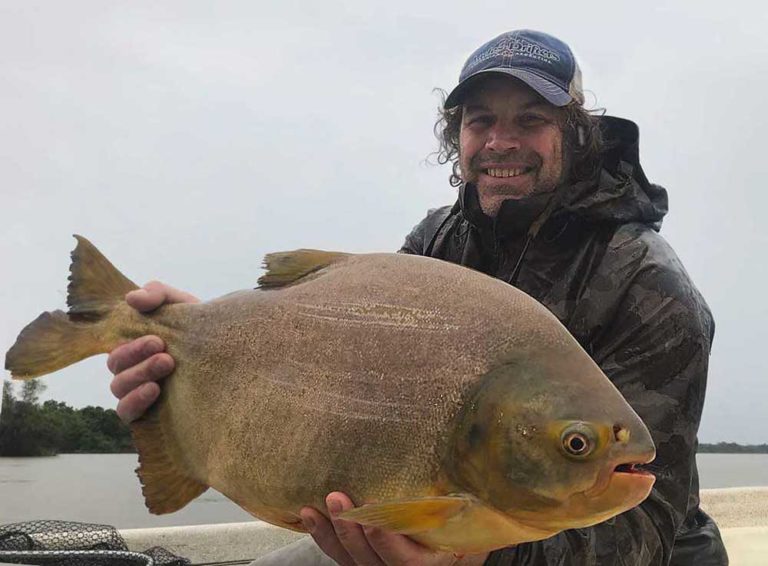
The section of the Upper Parana River that we fish has multiple side channels and streams beside the powerful main channel. The banks and almost every island are covered by a subtropical jungle, whose trees, bushes and plants overhang the water. This dense vegetation is a source of food and prey for the fish, providing them with mice, lizards, insects, fruits and nuts. We fish around trees that overhang the small channels and streams, since this where the fish often position themselves to feed. The best known trees and plants are: inga (produces a large yellow bean), laurel del rio (close to an olive in shape and size), tala (small round and orange fruit) and Francisco Alvarez (small red/purple fruit).
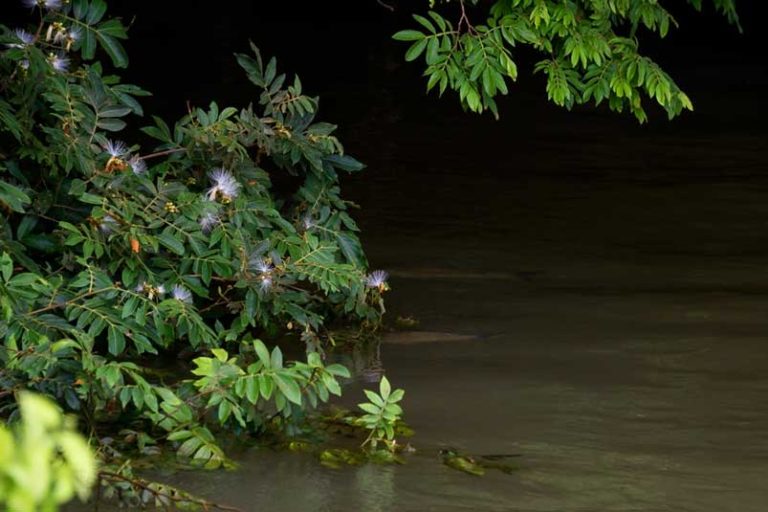
Most trout anglers are familiar with the use of terrestrials, attractor dry flies, and mouse patterns. We fish many of these patterns on the Upper Parana River when targeting the omnivorous species, but the size flies we use are muchlarger than you would use for trout. We tie the flies on strong hooks designed for saltwater fishing.
Our experienced guides will teach you some simple yet very effective strategies for catching pacu, pirapita, and boga. These strategies include twitching the flies, casting at the best angles, and reading the water that holds the fish. Our guides will also teach you how to mimic the sound the falling fruit makes when it lands in the water. This sound draws the fish to the area. When you mimic this sound with a fly and allow the fly to dead-drift, it triggers the fish to attack. It is also important to match the color and shape of what the fish are feeding on. Flies can be designed to sink or float back up to the surface, and tied with different materials, such as plastic beads, weighted foam, or silicone.
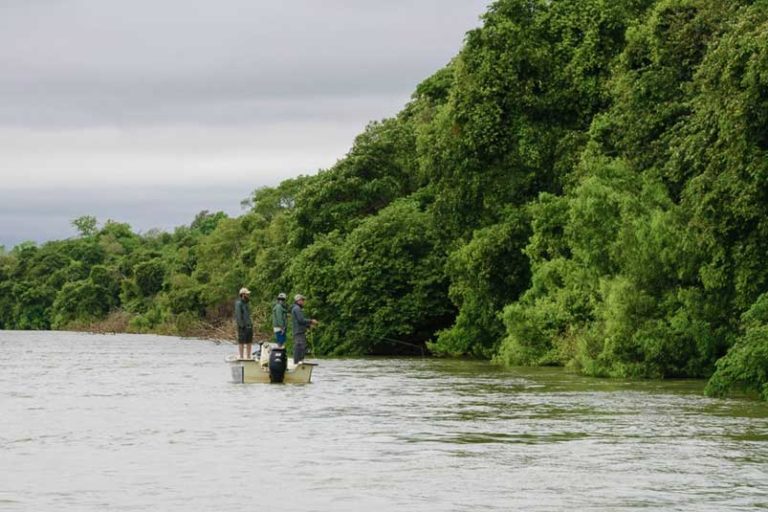
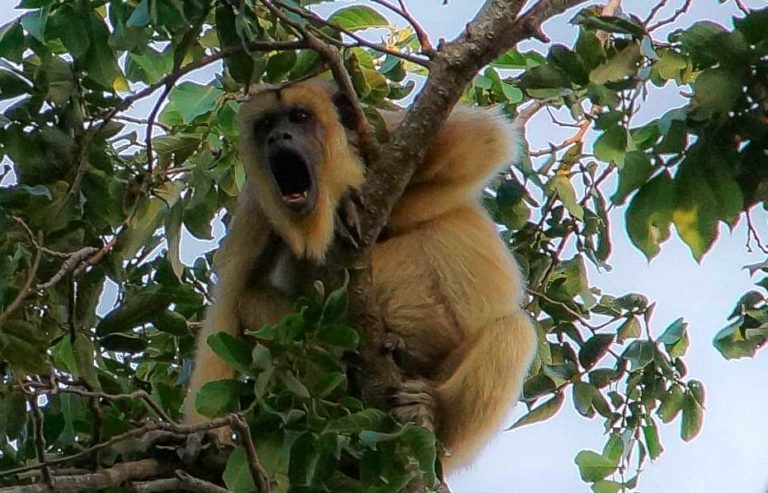
These omnivorous fish have adapted and grown teeth to effectively crush and feed on hard nuts and fruits. In the case of pacu, they have teeth very similar looking to human molars, letting them cut regular monofilament or fluorocarbon and occasionally even bend the strongest saltwater hooks available. So the use of short 30-pound wire tippets and the highest quality hooks are necessary. 6 weight or 7 weight rods are ideal and warm water floating lines are best.
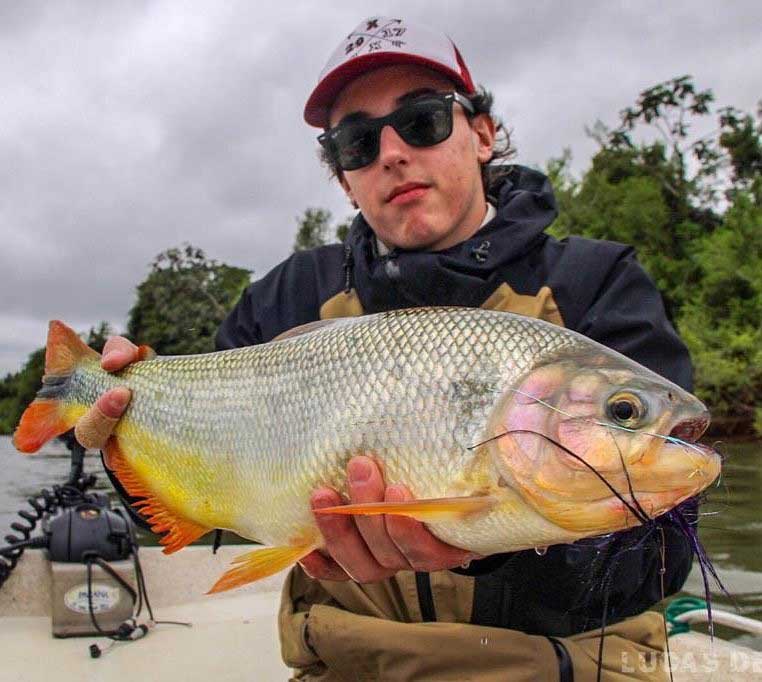
Other golden dorado articles
After 20+ years of fly-fishing and numerous destination trips, we were ready for our next adventure; “Big Yellow Toothy Fish”—Golden Dorado in Argentina!We booked a trip through an unfamiliar (to us) outfitter called SET Fly Fishing. Soon after, COVID stopped…
The common theme of conversation among guides and fishing friends, often while sitting around a campfire or gathered at a winter Asado, is always about fishing. And when the subject turns to Golden Dorado, the recurring question posed to the…
It's Official After two years of severe drought and unprecedented conditions across northeastern Argentina, which created some challenges and puzzles to find the best Golden Dorado fishing, water conditions have now recovered. Since October of 2022 the entire Parana River…
Explorations and New Fisheries Scouting keeps us going Presenting jetu'u Cabaña de Esteros Home waters are always special. They are the place you’ve known for a long time, and have come to learn every intimate detail. You’ve spent many hours…
For those who love adventure on the water, Jetu'u Lodge offers more than just exceptional fly fishing; it invites you to explore a rich cultural tradition deeply rooted in Argentina. Located near the serene landscapes from Santa Lucia to Esquina…
Catch-and-release can be an effective way to reduce impacts on recreationally targeted species, however just claiming “I already practice catch-and-release” isn’t good enough. There is a growing body of science that shows that how an angler fights, handles, and releases…
The first half of the Golden Dorado season at our lodges was nothing short of spectacular. Between September and December 2024, we welcomed 163 guests to our Golden Dorado lodges, and together we landed an impressive 5,441 Golden Dorado. That’s…
We understand that every angler is unique, with their own vision of the perfect fishing adventure. That’s why we’re excited to guide you to the best locations in Argentina for Golden Dorado fishing—places that are not just about the fish,…
Imagine waking up to the sound of rippling waters, the fresh air filling your lungs, and the excitement of a fishing adventure waiting for you. For most, the saying "A bad day of fishing is always better than a good…
Golden dorado are an iconic fish species of Neotropical watersheds. They are fierce predators that likely play an important ecological role in the waters they inhabit. Of course, their explosive strike, leaps, and beautiful colors put them on the bucket…
The thrill of fooling Golden Dorados with flies lies in the incredible visual action we witness with every strike, whether using a streamer fly or a topwater fly pattern. To succeed in catching Golden Dorado, our expert guides have curated…
For the past few years, a heavy heart hung over us at Set Fly Fishing. The once-majestic Ibera Wetlands, a haven for anglers and a vital ecosystem, had fallen victim to a historic drought. The lifeblood of the region dwindled,…
This question used to be a simple one to answer. Now, with the 3 separate destinations available in the Golden Dorado Experience it’s a bit more complex, but worth studying because of the variety of conditions where you can target…
Hi friends! We are finishing another fabulous spring Dorado season and this time with an extended Golden Dorado Experience, the first one after the inclusion of Jetu'u Cabanas de Esteros to the family of our lodges. And, there were many…
Some of you may now; Rachel Finn has been an ambassador and great friend for SET for several years now. She has been hosting groups regularly to all our lodges for golden dorado and trout.Last year we had the opportunity…
Also known as “Carlitos”, he has been a part of The Golden Dorado Experience since the beginning. He has accumulated more hours on the water chasing Dorados than any guide could wish for, and his knowledge about the species and…
The Golden Dorado Experience by SET Fly Fishing was recently completed with the addition of a third lodge, Jetu’u Cabañas de Esteros. But given that the lodges are all within a 55-minute flight of each other, some might wonder how…
I was lucky to be born and raised near the largest tributary of the La Plata basin, the beautiful Parana River. In my early teens my friends and I started fishing, first with conventional tackle and live bait, then artificial…
The Paisanos of the Ibera have survived for many generations in an intimate relationship with the land and waters of this beautiful ecosystem, making their living raising cattle and farming in family groups.In Argentina, the name “Paisano” was originally used…
At SET Fly Fishing we are always planning your next great adventure. From the beginning, we have been a team of passionate anglers and hardcore explorers with a vision - to bring the most exciting and adventurous fishing vacations to…
After 20+ years of fly-fishing and numerous destination trips, we were ready for our next adventure; “Big Yellow Toothy Fish”—Golden Dorado in Argentina!We booked a trip through an unfamiliar (to us) outfitter called SET Fly Fishing. Soon after, COVID stopped…
The common theme of conversation among guides and fishing friends, often while sitting around a campfire or gathered at a winter Asado, is always about fishing. And when the subject turns to Golden Dorado, the recurring question posed to the…
It's Official After two years of severe drought and unprecedented conditions across northeastern Argentina, which created some challenges and puzzles to find the best Golden Dorado fishing, water conditions have now recovered. Since October of 2022 the entire Parana River…
Explorations and New Fisheries Scouting keeps us going Presenting jetu'u Cabaña de Esteros Home waters are always special. They are the place you’ve known for a long time, and have come to learn every intimate detail. You’ve spent many hours…
For those who love adventure on the water, Jetu'u Lodge offers more than just exceptional fly fishing; it invites you to explore a rich cultural tradition deeply rooted in Argentina. Located near the serene landscapes from Santa Lucia to Esquina…
Catch-and-release can be an effective way to reduce impacts on recreationally targeted species, however just claiming “I already practice catch-and-release” isn’t good enough. There is a growing body of science that shows that how an angler fights, handles, and releases…
The first half of the Golden Dorado season at our lodges was nothing short of spectacular. Between September and December 2024, we welcomed 163 guests to our Golden Dorado lodges, and together we landed an impressive 5,441 Golden Dorado. That’s…
We understand that every angler is unique, with their own vision of the perfect fishing adventure. That’s why we’re excited to guide you to the best locations in Argentina for Golden Dorado fishing—places that are not just about the fish,…
Imagine waking up to the sound of rippling waters, the fresh air filling your lungs, and the excitement of a fishing adventure waiting for you. For most, the saying "A bad day of fishing is always better than a good…
Golden dorado are an iconic fish species of Neotropical watersheds. They are fierce predators that likely play an important ecological role in the waters they inhabit. Of course, their explosive strike, leaps, and beautiful colors put them on the bucket…
The thrill of fooling Golden Dorados with flies lies in the incredible visual action we witness with every strike, whether using a streamer fly or a topwater fly pattern. To succeed in catching Golden Dorado, our expert guides have curated…
For the past few years, a heavy heart hung over us at Set Fly Fishing. The once-majestic Ibera Wetlands, a haven for anglers and a vital ecosystem, had fallen victim to a historic drought. The lifeblood of the region dwindled,…
This question used to be a simple one to answer. Now, with the 3 separate destinations available in the Golden Dorado Experience it’s a bit more complex, but worth studying because of the variety of conditions where you can target…
Hi friends! We are finishing another fabulous spring Dorado season and this time with an extended Golden Dorado Experience, the first one after the inclusion of Jetu'u Cabanas de Esteros to the family of our lodges. And, there were many…
Some of you may now; Rachel Finn has been an ambassador and great friend for SET for several years now. She has been hosting groups regularly to all our lodges for golden dorado and trout.Last year we had the opportunity…
Also known as “Carlitos”, he has been a part of The Golden Dorado Experience since the beginning. He has accumulated more hours on the water chasing Dorados than any guide could wish for, and his knowledge about the species and…
The Golden Dorado Experience by SET Fly Fishing was recently completed with the addition of a third lodge, Jetu’u Cabañas de Esteros. But given that the lodges are all within a 55-minute flight of each other, some might wonder how…
I was lucky to be born and raised near the largest tributary of the La Plata basin, the beautiful Parana River. In my early teens my friends and I started fishing, first with conventional tackle and live bait, then artificial…
The Paisanos of the Ibera have survived for many generations in an intimate relationship with the land and waters of this beautiful ecosystem, making their living raising cattle and farming in family groups.In Argentina, the name “Paisano” was originally used…
At SET Fly Fishing we are always planning your next great adventure. From the beginning, we have been a team of passionate anglers and hardcore explorers with a vision - to bring the most exciting and adventurous fishing vacations to…
After 20+ years of fly-fishing and numerous destination trips, we were ready for our next adventure; “Big Yellow Toothy Fish”—Golden Dorado in Argentina!We booked a trip through an unfamiliar (to us) outfitter called SET Fly Fishing. Soon after, COVID stopped…
The common theme of conversation among guides and fishing friends, often while sitting around a campfire or gathered at a winter Asado, is always about fishing. And when the subject turns to Golden Dorado, the recurring question posed to the…
It's Official After two years of severe drought and unprecedented conditions across northeastern Argentina, which created some challenges and puzzles to find the best Golden Dorado fishing, water conditions have now recovered. Since October of 2022 the entire Parana River…
Explorations and New Fisheries Scouting keeps us going Presenting jetu'u Cabaña de Esteros Home waters are always special. They are the place you’ve known for a long time, and have come to learn every intimate detail. You’ve spent many hours…

